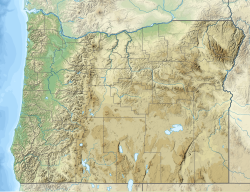| Cornucopia Peak | |
|---|---|
 South aspect | |
| Highest point | |
| Elevation | 8,643 ft (2,634 m) [1] [2] |
| Prominence | 430 ft (131 m) [3] |
| Isolation | 1.18 mi (1.90 km) [4] |
| Coordinates | 45°01′13″N117°14′19″W / 45.0201884°N 117.2384738°W [5] |
| Naming | |
| Etymology | Cornucopia |
| Geography | |
| Location | Eagle Cap Wilderness |
| Country | United States of America |
| State | Oregon |
| County | Baker |
| Parent range | Wallowa Mountains |
| Topo map | USGS Cornucopia |
| Geology | |
| Rock type | granitic Cordierite Trondhjemite [6] |
| Climbing | |
| Easiest route | scrambling [2] |
Cornucopia Peak is a mountain summit located in Baker County, Oregon, US. [5]


